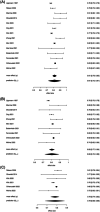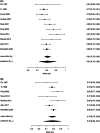Machine learning to predict adverse outcomes after cardiac surgery: A systematic review and meta-analysis
- PMID: 36001761
- PMCID: PMC9804388
- DOI: 10.1111/jocs.16842
Machine learning to predict adverse outcomes after cardiac surgery: A systematic review and meta-analysis
Abstract
Background: Machine learning (ML) models are promising tools for predicting adverse postoperative outcomes in cardiac surgery, yet have not translated to routine clinical use. We conducted a systematic review and meta-analysis to assess the predictive performance of ML approaches.
Methods: We conducted an electronic search to find studies assessing ML and traditional statistical models to predict postoperative outcomes. Our primary outcome was the concordance (C-) index of discriminative performance. Using a Bayesian meta-analytic approach we pooled the C-indices with the 95% credible interval (CrI) across multiple outcomes comparing ML methods to logistic regression (LR) and clinical scoring tools. Additionally, we performed critical difference and sensitivity analysis.
Results: We identified 2792 references from the search of which 51 met inclusion criteria. Two postoperative outcomes were amenable for meta-analysis: 30-day mortality and in-hospital mortality. For 30-day mortality, the pooled C-index and 95% CrI were 0.82 (0.79-0.85), 0.80 (0.77-0.84), 0.78 (0.74-0.82) for ML models, LR, and scoring tools respectively. For in-hospital mortality, the pooled C-index was 0.81 (0.78-0.84) and 0.79 (0.73-0.84) for ML models and LR, respectively. There were no statistically significant results indicating ML superiority over LR.
Conclusion: In cardiac surgery patients, for the prediction of mortality, current ML methods do not have greater discriminative power over LR as measured by the C-index.
Keywords: artificial intelligence; cardiac surgery; machine learning; meta-analysis; perioperative risk; systematic review.
© 2022 The Authors. Journal of Cardiac Surgery published by Wiley Periodicals LLC.
Figures





Comment in
-
Will artificial intelligence help us in predicting outcomes in cardiac surgery?J Card Surg. 2022 Nov;37(11):3846-3847. doi: 10.1111/jocs.16844. Epub 2022 Aug 24. J Card Surg. 2022. PMID: 36001760 Free PMC article. No abstract available.
References
-
- Ripley BD. Pattern Recognition and Neural Networks. Cambridge University Press; 1996. 10.1017/cbo9780511812651 - DOI
Publication types
MeSH terms
LinkOut - more resources
Full Text Sources
Medical
Miscellaneous

